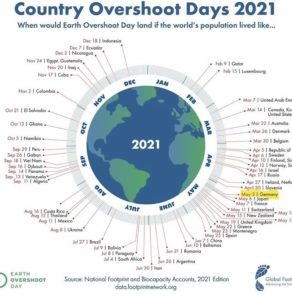The fact that we, the human race, live beyond our means and are almost unrestrained exploiters of our home planet shouldn’t be news. Almost all of our everyday habits, especially travelling and being mobile, contribute significantly to the consumption of finite resources.
This Thursday (29 July 2021) highlights this fact even more, as today marks what is known as Earth Overshoot Day. The day on which humans will have used more resources than the Earth can produce within a year. In order to calculate this date, UN statistics on the ecological footprint of humanity and biocapacity are taken from a specific year, divided and multiplied by 365. The result is the Earth Overshoot Day of a given year. By the way, the same can also be calculated for each individual country:

Since 1970, we can see that the Earth Overshoot Day is moving further and further back – this year already to the end of July. A crucial sign and an important signal that not enough is being done to reduce the negative impact of human life on the environment.

Earth Overshoot Day: an important message for a rapid change in transport policy
Private motorised transport contributes significantly to the deterioration of air and climate. This is mainly due to our increased level of mobility, which in Germany alone has almost doubled in the past forty years, with the main means of transport still being the individual car – with an upward trend.
Whereas in 2000 there were still 532 cars per 1000 inhabitants, this number has risen to 580 cars per 1000 inhabitants by 2020. This development is burdening the environment in many ways: air pollution is increasing due to the growing emission of pollutants, in addition, more and more cars require more and more space, which leads to a large-scale sealing of the natural soil.
In Germany, almost half of the ground surface is sealed, among other things to create more space for roads and parking spaces – with disastrous effects. In recent weeks, we have witnessed at first hand the consequences of human intervention in natural habitats: Rain can no longer be absorbed as easily by the ground, existing sewage systems can no longer cope with the masses of water, flooding may result.
All these scenarios, which already have a massive impact on our lives, should wake us up: the transformation of transport is an important part of reducing harmful human-made environmental impacts and must therefore be implemented as soon as possible.
Earth Overshoot Day: How can the change in transport look like?
It has long been obvious that a shift in mindset is necessary when it comes to transport. The task now is to create incentives that make it easier for people to switch to shared modes of public mobility. Only then will it be possible to reduce the approximately 17% of global CO2 emissions caused by our mobility behaviour and to conserve the earth’s resources.
Our existing habits play a decisive role in this. Car drivers are used to getting around easily: Roads are everywhere, detours or subsequent longer walks to the destination are almost non-existent, huge areas are covered with concrete so that cars, which spend a large part of the day just standing around, can be parked almost anywhere. These and other amenities have educated us to use the car. But this behaviour can also be changed.
To do so, it requires two things: 1) making the use of public, shared transport more attractive and 2) making the use of one’s own car less attractive.
Of course, these demands are not fully applicable to all people and life situations. People who live in rural areas are usually dependent on using their own car, while public transport hardly operates or does not do so on a regular basis.
A fair balance must therefore be created that benefits everyone and does not penalise those who are particularly reliant on a car. For example, people who move out of the cities because they cannot afford an expensive city residence, but still have to commute far to their workplace every day.
An attractive shared mobility offer can be created when mobility options are developed that actually correspond to the reality of people’s lives. These can be employee shuttles (for big companies) or on-demand feeder services that take people to main transport hubs that they cannot easily reach on foot or by bike.
A good example of how such Demand-Responsive Transport services are catching on is, for example, the Clam’Express in the greater Paris region. With a fleet of electric vehicles, people are comfortably transported the first and last kilometres from their home to their destination. The service stops at hubs where passengers can easily transfer to the regular transport network. The Clam’Express is inclusive, allowing people with reduced mobility to effortlessly book and use it.
Further solutions for rural mobility, especially a Mobility as a Service (Maas) approach can be reviewed in our current White Paper. A link to download it is available at the bottom of this article.
Financial incentives, such as discounted tickets for employees or free tickets for senior citizens (at certain times), as is the case in the UK through the “Older People Freedom Pass“, should also be considered by governments to make public transport more attractive options for more people.
On the other hand, persons who drive every kilometre with their own car and occupy large parts of the public space should be charged significantly higher parking fees, for example.
Earth Overshoot Day: What does the future hold?
Under the hashtag #MoveTheDate, solutions are being collected online to help push back the Earth Overshoot Day.
The solutions listed above, along with other incentives to make public shared transport a ‘normal’ means of transport for the general public, can enable us to move Earth Overshoot Day back by 13 days (compared to today). Saving 50% of current mobility-related emissions is already enough. In other words, about one-third of all journeys usually made by car should be replaced by public transport.
A demand that certainly is not utopian. Decision-makers are now obliged to pave the way for an effective change in transport. Innovative ideas and products for this already exist and only need to be used effectively and distributed fairly.
This interview about “Empirical Evidence on Demand-Responsive Transport Services” might interest you as well.





